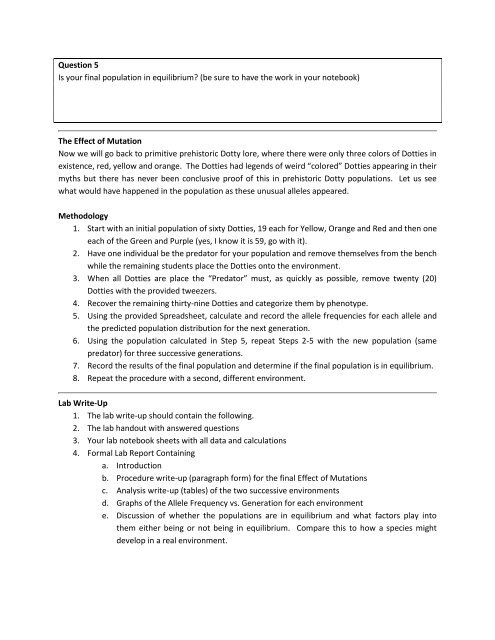Population Genetics and Hardy-Weinberg Populations Lab General ...
Population Genetics and Hardy-Weinberg Populations Lab General ...
Population Genetics and Hardy-Weinberg Populations Lab General ...
Create successful ePaper yourself
Turn your PDF publications into a flip-book with our unique Google optimized e-Paper software.
Question 5<br />
Is your final population in equilibrium? (be sure to have the work in your notebook)<br />
The Effect of Mutation<br />
Now we will go back to primitive prehistoric Dotty lore, where there were only three colors of Dotties in<br />
existence, red, yellow <strong>and</strong> orange. The Dotties had legends of weird “colored” Dotties appearing in their<br />
myths but there has never been conclusive proof of this in prehistoric Dotty populations. Let us see<br />
what would have happened in the population as these unusual alleles appeared.<br />
Methodology<br />
1. Start with an initial population of sixty Dotties, 19 each for Yellow, Orange <strong>and</strong> Red <strong>and</strong> then one<br />
each of the Green <strong>and</strong> Purple (yes, I know it is 59, go with it).<br />
2. Have one individual be the predator for your population <strong>and</strong> remove themselves from the bench<br />
while the remaining students place the Dotties onto the environment.<br />
3. When all Dotties are place the “Predator” must, as quickly as possible, remove twenty (20)<br />
Dotties with the provided tweezers.<br />
4. Recover the remaining thirty-nine Dotties <strong>and</strong> categorize them by phenotype.<br />
5. Using the provided Spreadsheet, calculate <strong>and</strong> record the allele frequencies for each allele <strong>and</strong><br />
the predicted population distribution for the next generation.<br />
6. Using the population calculated in Step 5, repeat Steps 2-5 with the new population (same<br />
predator) for three successive generations.<br />
7. Record the results of the final population <strong>and</strong> determine if the final population is in equilibrium.<br />
8. Repeat the procedure with a second, different environment.<br />
<strong>Lab</strong> Write-Up<br />
1. The lab write-up should contain the following.<br />
2. The lab h<strong>and</strong>out with answered questions<br />
3. Your lab notebook sheets with all data <strong>and</strong> calculations<br />
4. Formal <strong>Lab</strong> Report Containing<br />
a. Introduction<br />
b. Procedure write-up (paragraph form) for the final Effect of Mutations<br />
c. Analysis write-up (tables) of the two successive environments<br />
d. Graphs of the Allele Frequency vs. Generation for each environment<br />
e. Discussion of whether the populations are in equilibrium <strong>and</strong> what factors play into<br />
them either being or not being in equilibrium. Compare this to how a species might<br />
develop in a real environment.


